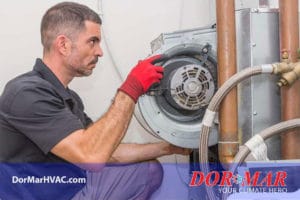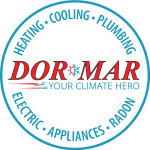In this two-part post, we examine the most common problems that we see when we go out on furnace service calls. Here is part 2. Miss part 1? Review it here: https://dormarhvac.com/top-furnace-problems-part-1-of-2/
- Bad Control Board
Frequently found right on the front of the furnace, this is an electronic board that manages much of the electric function of the furnace. Customers will call and say their furnace isn’t working at all, or is doing something weird, like the fan will not turn off or both the AC and the furnace will run at once. Often, when we remove the control board on the underside we will see burn marks. - Bad Gas Valve
When the gas valve is bad, the furnace will appear to start up normally, the inducer motor will start, the pressure switches will close, the ignitor will blow, but that’s it. Nothing else happens, it just shuts off. Sometimes, customers will accidentally shut off the gas to the furnace (when they meant to shut it off to a water heater) and get the same result. In that instance, you’ll actually hear the gas valve open (so it’s an easy fix). Otherwise, you’ll have to replace the complete gas valve. - Bad heat exchanger
The heat exchanger is the main component of the furnace that separates your house air from the combustion fumes that go out the chimney. Usually it’s a tubular shaped thing that kind of snakes back and forth, or sometimes it’s split up into cells. The idea is to keep the heat inside the furnace longer before it goes up the chimney. Sometimes those tubes crack. While they are designed to last about as long as the furnace (usually 15 years) some things can cause them to fail sooner. A excessively dirty filter can cause the furnace to overheat constantly, causing the heat exchanger to fail prematurely. A plugged a-coil or bad duct work can also cause the failure. We test with a combustion analyzer in the exhaust, and if the carbon monoxide is very high, that could indicate the heat exchanger is bad. We usually recommend a new furnace if the heat exchanger is bad. Code states that if there is a crack in the heat exchanger, the heat exchanger or the entire furnace must be replaced. - Bad Ignitor
When the customer calls and says the furnace seems to start working, but never actually lights, it could be a bad ignitor, whose job is to ignite the gas coming into the furnace. If the ignitor gets 120 volts but never glows, or there is no resistance when the power is unplugged, the ignitor is bad. Generally, you’ll hear the inducer motor come on, the gas valve open, but the furnace just won’t fire up. This indicates the ignitor needs to be replaced. - Plugged Evaporator Coil (A-Coil)
The Evaporator Coil looks like a radiator, is part of the air conditioning system and sits atop the furnace. If it becomes plugged with dirt because of a lack of maintenance (not changing the furnace filter often enough, or using a filter that doesn’t filter out enough dirt) then it can cause the furnace to overheat and shut down. It can be difficult to access, but we recommend getting it cleaned to ensure this doesn’t happen. - Bad Ignition Module
This is another control board that manages just the ignition of your furnace. It only controls the gas valve, the spark ignitor, and the flame sensor. Some furnaces do not have a separate ignition module. We check it with a meter to see if it’s sending power to the gas valve or spark. If not, it needs to be replaced. - Bad Thermostat
The thermostat is the control unit installed on the wall in the living area (usually the living room) of a house, allowing the homeowner to control the home’s temperature. When a thermostat is bad, you’ll switch the furnace on and nothing will happen. We check it by bypassing the thermostat by jumpering a couple of contacts with the thermostat disconnected. If the furnace starts normally using this procedure, then we place the thermostat. (We recommend a smart WiFi thermostat) - Dirty Pilot Assembly
Older furnaces have a pilot light or gas flame, just waiting for the furnace controls to tell it to light the burners. Sometimes the flame may not be hitting the flame sensor as it should, or there is a weak or lazy flame in the pilot. Usually this means there is a tiny orifice plugged with dirt in the pilot assembly. Opening and cleaning the assembly properly solves the problem. - Plugged Condensate Trap
A forced air system relies on adjusting both the temperature and humidity of outside air before it is distributed throughout the home. The condensation has to be removed, so the furnace contains a condensate trap and drain line. A plugged trap can cause leaks and water damage inside the furnace, and cause the unit to not operate properly.
Remember, as we get into the fall and cool weather is approaching, be sure to call Dor-Mar and schedule your annual maintenance for the safety and protection of your family and the biggest investment of your life – your home.
Schedule an appointment for your Furnace Tune-Up with us today by using our online contact form, or call one of our seven neighborhood offices.. We pride ourselves on our customer-focused service, and our reviews show it.
NEWARK 740.345.6639 • COLUMBUS 614.238.6689 • DUBLIN 614.545.8939 • REYNOLDSBURG 614.365.1579 • WESTERVILLE 614.381.1540 • GROVE CITY 614.595.3098 • ZANESVILLE 740.454.2420
Dor-Mar…Your Climate Hero!













